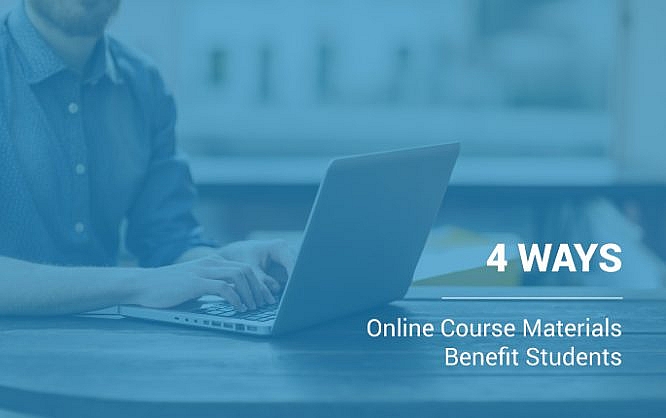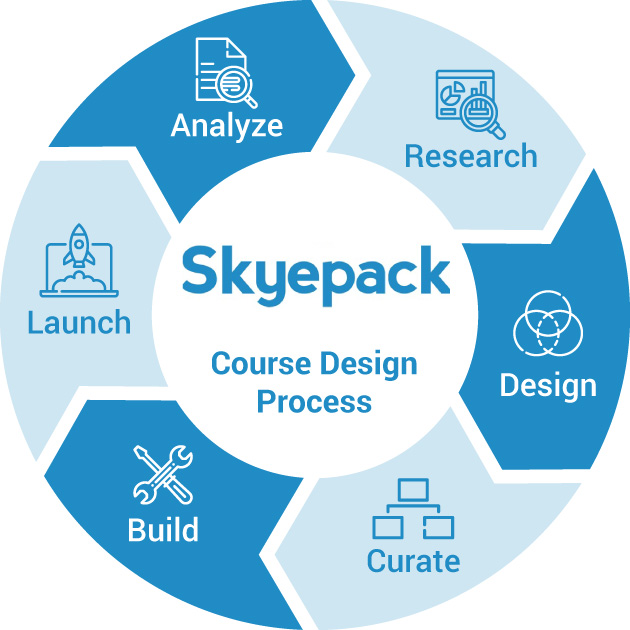4 Ways Online Course Materials Benefit Students

At all levels of education, many instructors are implementing modern practices and innovative technology into their lesson plans. In both the K-12 and higher education sectors, the rise of educational technology (often referred to as EdTech) has been impossible to miss.
In 2020, the need for digital tools has been more pressing and sudden than ever before. Due to the COVID-19 pandemic, teachers and professors had to adapt to online learning with little advance notice. Now, online and hybrid classrooms are commonplace as social distancing recommendations continue.
Even when typical in-person learning is possible, EdTech is still central to effective teaching and learning. Different EdTech tools can address the various challenges faced by educators each day.
One such challenge is choosing a textbook. The historical textbook publishing industry created a market that is expensive and inflexible. But now, options for digital course materials are new and useful alternatives to the traditional landscape of educational resources.
Online course materials are beneficial to instructors, but they have many advantages that are specific to the needs of students, including:
- Online course materials are usually more affordable.
- Online course materials are convenient and easy to use.
- Online course materials are engaging and interactive.
- Online course materials can be tailored to meet student needs.
All of these benefits may convince you to break up with traditional textbooks in favor of online course materials—your students will probably thank you!

1. Online course materials are usually more affordable.
It’s no secret that textbooks are expensive. Between 1977 and 2015, college textbook costs increased by an astounding 1041%. And since new editions are frequently released, these pricey books can quickly become outdated. Some communities may even need to hold fundraisers to combat the rising costs of materials. As Re:Charity discusses, just coming up with ideas for school fundraisers is a massive undertaking for already busy parents and teachers, let alone executing the entire campaign.
In response to this landscape, there’s been a strong push for more affordable textbooks, especially in higher education. And corresponding with the popularization of EdTech, people are looking to online tools to solve the problem.
Generally, online course materials are any kind of instructional material that can be accessed from a computer or mobile device.
This broad definition encompasses a few major types of digital course materials at different price points, including:
- E-textbooks. E-textbooks are digitized versions of physical course materials, and they may include additional interactive elements like quizzes. But despite being digital, e-textbooks aren’t usually much more affordable than traditional textbooks. Typically, these e-textbooks are still part of the traditional publishing landscape, and the price tags reflect that. The access codes for these are often nearly as expensive as the textbooks themselves!
- Open educational resources (OERs). These educational materials are openly licensed to be freely used and modified by instructors and their students. An OER can be something as simple as an individual image or as extensive as an entire online course. However, since these materials are completely free (hence “open”), they can vary widely in quality. Cobbling together enough trustworthy OERs to align with your entire syllabus can be a time-consuming process.
- Custom course materials. As this guide to digital course materials discusses, some professors are opting for instructional design teams to curate a selection of peer-reviewed resources that meet their course objectives. Customized digital course materials can be provided to students at a much lower price point than traditional textbooks but with more confidence than an OER.
In order to choose course materials that are a good fit for your school, you’ll need to consider factors like availability, price, and trustworthiness of the source.

2. Online course materials are convenient and easy to use.
Physical textbooks can be difficult to acquire, cumbersome to carry around, or otherwise difficult to manage. Technology makes it easier for students to learn in an environment that best suits their needs.
Online course materials are more convenient for students because they are:
- Centralized. With a set of digital course materials, all the right information is in one place, in the right order. There’s no need to jump around from chapter to chapter or sort through PDF files to find the week’s reading assignments.
- Immediately available. Physical textbooks can be challenging to secure at the beginning of the semester. Between lines at campus bookstores and online vendor shipping times, it can be days or even weeks before students can start the reading. Opting for online course materials means students can get day-one access to their required content.
- Multi-platform. Online course materials can be accessed on various devices including laptops, smartphones, and tablets, so students can easily access content while on-the-go.
- Accessible. Online materials typically have built-in features to meet accessibility standards for the use of assistive technologies like screen readers.
If students are working from home in online classrooms, it’s not as critical to worry about them carrying around heavy textbooks in backpacks, but convenience is still a major benefit of online course materials.
Plus, at the end of the semester, students using online materials won’t need to return rentals or resell books. If they need to reference the material for a later course or as a resource in their career down-the-line, they will still have access to the information.

3. Online course materials are engaging and interactive.
A physical textbook offers limited options for interactivity. Printed words and images are useful for conveying material, but EdTech enables learning through a wider range of activities.
With online course materials, students can learn through interactive and multimedia resources to enrich their experience.
Digital materials often include:
- Embedded assessments. Students can evaluate their learning during the learning process—without needing to flip through the back of a textbook to find an answer. Integrating online quizzes and assignments within the course materials also helps instructors to see which topics students are struggling to understand.
- Interactive content. Gamified or drag-and-drop elements allow kinesthetic learners to engage with the material effectively.
- Multimedia elements. In addition to traditional images and charts, content like audio clips, videos, and animation can be incorporated alongside written material for greater learner engagement.
These elements can more effectively connect with students of different learning styles. Additionally, interactive materials are much more engaging and interesting for students than a plain textbook!

4. Online course materials can be tailored to meet student needs.
One of the most notable benefits of online course materials is their adaptability.
After all, every group of students is different, from commuter campuses to intro-level lectures to complex graduate seminars. Unlike a traditional textbook, digital materials can be curated to fit a professor’s course objectives and meet the needs of specific groups of students.
This still holds true even as the needs of students might change over time or between semesters. Digital course materials can be continuously improved and updated to reflect student feedback and performance.
To explore this concept further, let’s take a look at Skyepack’s curriculum development process:

This is an iterative process for designing course materials based on Agile methodology. The point of this cycle is to make improvements that continue to benefit students.
The six steps of the cycle are:
- Analyze. Instructional designers evaluate the needs of students and instructors.
- Research. The design team explores available resources to meet those needs.
- Design. The layout and flow of the course are developed for optimum student engagement.
- Curate. Peer-reviewed open-source content and other resources are collected to create a comprehensive set of materials.
- Build. The Skyepack team builds the course materials in a collaborative process with the instructor.
- Launch. Students get day-one access to course materials that are built to prioritize their learning needs.
- Revise. The digital course materials can be adjusted as circumstances change.
While not all digital course materials must be created with these six steps, it’s still a helpful framework for thinking about how online material can be tailored to fit the needs of students.
Instructors are always looking for new ways to improve their teaching and enhance the learning experience for their students. Traditional textbooks are expensive, inconvenient, and one-size-fits-all, creating a negative or inaccessible learning environment for K-12 and college students. Digital course materials are the answer to many of these challenges and offer powerful advantages for students.
